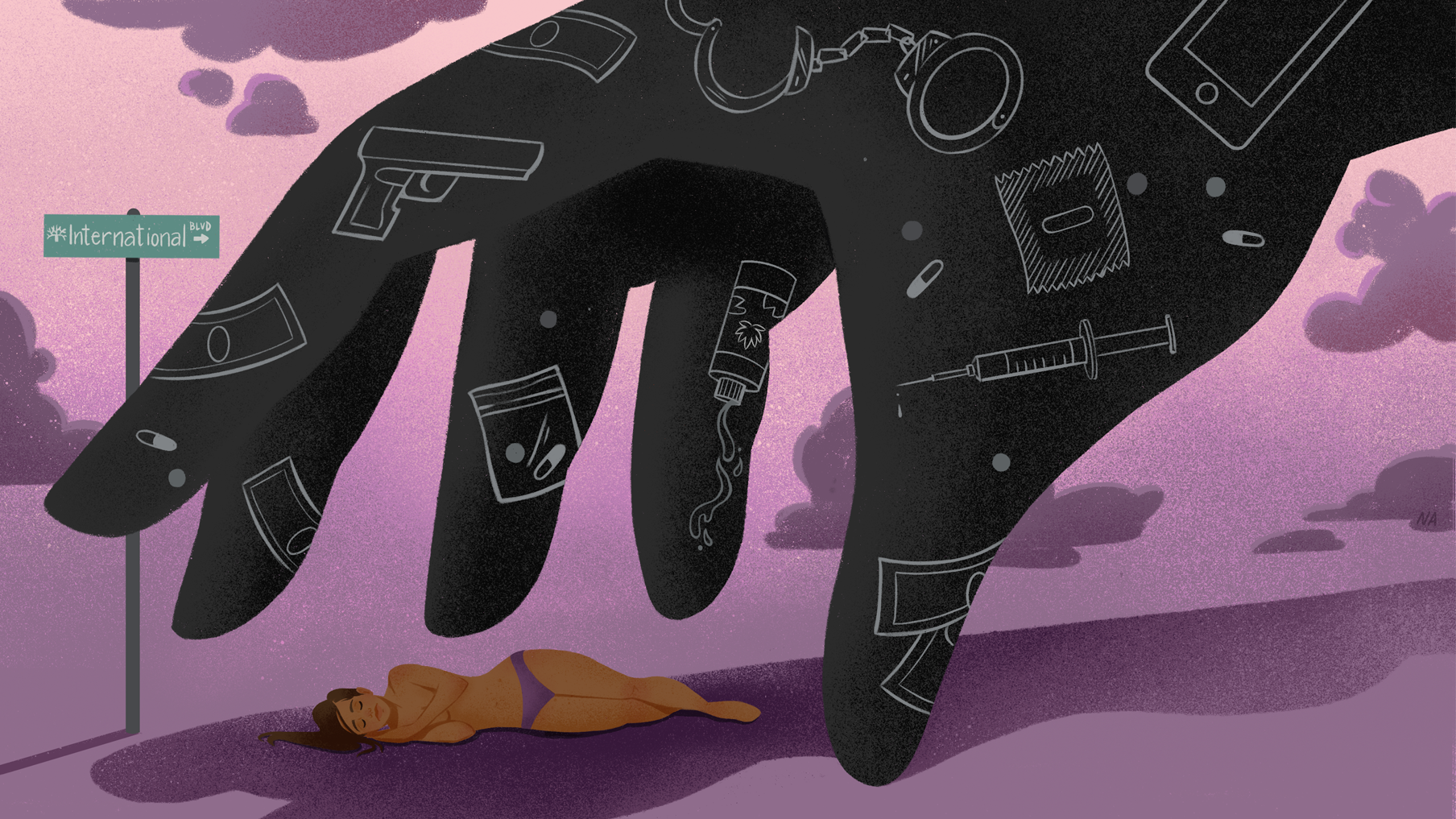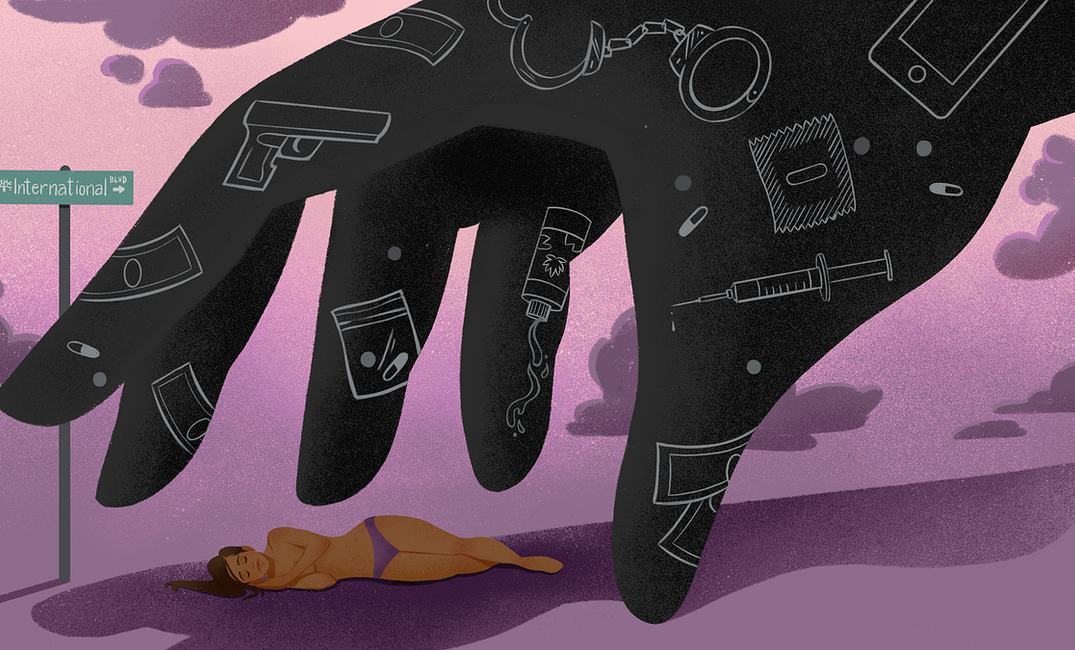
I vividly remember the night in 2012. It was date night with my husband, and as we were driving down Broadway in Oakland, we pulled up behind a Range Rover with a booming sound system. We were in front of Picán (the now-defunct southern restaurant) when a young girl teetered out onto the sidewalk in toothpick heels and a mini skirt. Off balance, with her eyes rolling around, she ducked into the window of the Range Rover and took a handful of cash. Within seconds, she was swept up into the car. The red light turned. So did my stomach.
“Woah,” my husband said, as I grasped for words to give meaning to what we’d witnessed. At some point, the word “prostitute” tumbled out of our mouths. I was quiet on the date and didn’t eat much. I kept seeing the pink hue in her heels, a flash of stolen innocence. Was she a minor under all that makeup? The baby fat in her face indicated that she was.
“Damn, I should have reported the license plate,” I thought to myself. “Then again, she’d taken the money.” What would I tell the police I’d seen? A girl getting her sea legs for street life, taking her first steps into the arms of a predator? I didn’t end up reporting what I saw, and still, there was something else bothering me.
Then it clicked: that could have been me at age 13, the awful adolescent age when a girl questions her worth and her place and is desperate for love and attention. And if she has a nose for adventure (like I did) and is willing to get into a car with an attractive guy to escape her troubles, it’s a fast road to ruin.
Thankfully for me, it was the love of my family that reeled me back to safety. But many girls come from foster care or shattered homes with histories of trauma and abuse, which makes them vulnerable to anything that looks like love. Maybe that was the only difference between me and the girl in the pink heels—our pasts. Maybe she believed she’d find love in the driver’s seat of a British SUV.
I now know that what I saw in 2012 was an instance of sex trafficking. In California, the age of consent is 18, without the act being considered statutory rape. The average age of exploited youth in the U.S. is 12 to 14. I’ve since learned that a pimp is a sex trafficker, and a sex trafficker is a pimp—even when pop culture makes light of the word “pimp” or glamorizes it. Pimps coerce and exploit victims and will go to any length for their own gain.
Where the waters get murky is the talk of prostitution (or “sex worker”) and sex trafficking, but think about it—a “worker” must be age 18 or over. A popular slogan resurfaced this past summer, when 45 people were arrested in Alameda County as part of a nationwide sting: “There is no such thing as a child prostitute.”
“Traffickers and abusers in other states know that you can come to Oakland to buy children. This issue affects every single child,” a narrator said in the film Surviving International Boulevard, which details the injustice of children for sale in Oakland. Only last week, a U.S. District Judge sentenced an Oakland man to 14 years in federal prison after he met a teen girl through Facebook, and had her trafficked the very next day on International Boulevard.
International Boulevard (a.k.a. “The Blade”) in Oakland is notorious for minors being sex-trafficked, and it’s most visible there. But traffickers do business in every nearby county around the Bay by luring in johns (sex buyers) through backdoor sites or popular review apps such as Rubmaps.
In fact, California consistently has the highest number of human-trafficking incidents reported in the U.S., according to the National Human Trafficking Hotline. And the FBI has called San Francisco “one of the world’s major sex-trafficking hubs,” the San Francisco Chronicle reported.
Alameda County’s H.E.A.T Watch reported that local at-risk youth in the Oakland area who are subject to commercial sexual exploitation, or youth who are already in “the life” as it’s referred to, can be broken down as a group as follows: 98% are girls; 1% are boys; and 1% are transgender individuals. Of these youth, 64% are African American; 15% are Latino/a; and 11% are Caucasian; and the rest are of other races.
They say that a hub like ours makes it easy for traffickers to move their victims in and out of the many airports, like the ones in San Francisco, Oakland and San Jose, which are all international airports.
How has the Bay Area, the tech and data capital of the world, swept these alarming statistics under the rug? Why is this happening, and why aren’t we hearing more about it?
“There is a public perception that prostitution is a consensual transaction. This couldn’t be further from the truth,” said Aron J. DeFerrari, a deputy district attorney in Contra Costa County. “The majority the public perceives as ‘prostitutes’ are in fact victims of sex trafficking. They are being coerced through physical force, fear, emotional coercion, false promises, or drug dependency. The sex ‘trade’ is really not a form of trade at all; rather, it’s the practice of modern-day slavery.”
With 40.3 million human-trafficking victims globally, as stated by the International Labour Organization, Alameda County statistics are hard to come by — largely because these cases appear as domestic violence or other crimes. “Trafficking” means that a trafficker (a pimp) will slip under the law’s detection by moving their victims around to different cities and ethnic enclaves.
“Measuring local stats as increasing or decreasing is difficult because trafficking is not well tracked in our justice system, and the crime occurs so deeply under the radar,” Brian Wo, co-founder of the Bay Area Anti-Trafficking Coalition, told me.
Some authorities, like Wo, attribute the Bay Area’s epidemic to the many diverse transportation options. They say that a hub like ours makes it easy for traffickers to move their victims in and out of the many airports, like the ones in San Francisco, Oakland and San Jose, which are all international airports.
“Incidents have also been reported on buses and with ride-share companies,” said Wo. “If the victims don’t know where they are, don’t make connections with people around them, or are far from friends and family, it’s much more difficult for a victim to escape.”
Vanessa Russell, founder of Love Never Fails, an East Bay nonprofit that helps restore, educate, and protect victims, goes a step further, explaining that “the most compelling reasons have to do with the existence of extreme affluence in the Bay Area alongside the existence of extreme poverty and vulnerability, especially among women and people of color.”
There is a desperate need to make ends meet for families and individuals living in economic disparity. It’s also true that a crime can exist only in the context of supply and demand — both of which are sky-high in places such as Oakland.
“The economic boom in San Francisco definitely impacts trafficking,” Wo said. “It increases demand, which, in turn, incentivizes traffickers to provide more supply. The demand comes from men, typically, who work in office jobs. They make ‘dates’ online in the afternoons from their office. Silicon Valley is full of men who fit this description.”
Fortunately, some women find light at the end of the dark tunnel. For example, the I AM House safe-housing program, a restoration component of Love Never Fails, includes multiple phases that take a survivor from victimization to advocacy.
“I used to feel I was in a nightmare. Now I will do everything I can to stop the next young woman from having to go through that,” said Brianna, age 19, a survivor and learning advocate whose words appear on a Love Never Fails brochure.
Although my own story of awareness began in 2012, it didn’t continue until 2017, when I read an excerpt from The Last Girl by Nadia Murad, an autobiography that describes how the author was captured and enslaved by the Islamic State. Coincidentally, that night I watched a movie called Priceless, the true story of two sisters who crossed the Mexico–United States border and were unknowingly sold into a sex-trafficking ring.
I told a friend that I couldn’t get human trafficking off of my mind. She suggested I meet Katrina Watson, the founder of Reviving Hearts//Renewing Dreams (R//R), a nonprofit that helps foster girls escape “the life.” When I first met Watson, she explained that everyone has a past, everyone is broken in some way, and every girl deserves restoration. As she spoke, I was so inspired that I joined R//R’s board with the vision of opening a safe refuge for survivors.
My journey into the freedom fight against sex trafficking isn’t coincidental. I believe in a higher power. But no matter what your convictions are, sex trafficking isn’t a religious or a political issue — it’s a human-life issue. I hope to right a wrong I made years ago when I didn’t get out of my car and fight for that girl. I hope to make sense of my own tumultuous past. I hope to help girls fight for their dignity.







